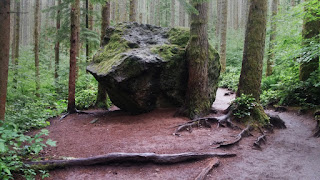Today was my third hike at Twin Falls east of North Bend, and it turned out to be a sea change. My energy levels were up, resulting in faster, sustained hiking and much greater distance. I and my hiking companion, Tammi Hermann, followed the Twin Lakes Trail all the way to its intersection with the Iron Horse Trail, which can be accessed at exit 38 on the I-90 Interstate. (Twin Falls is accessed at exit 34.)
(I am wondering whether the 30-minute nap I took in my car before the hike, and the 16-oz. can of Mountain Dew I drank just before the hike had anything to do with my renewed vim and vigor. Or maybe it was the rebound from the two hike I did a week earlier. Inquiring minds want to know.)
 |
Tammi Hermann, my hiking companion.
|
We left the trailhead at 11:02 a.m. and returned at 3:45 p.m. I used Map My Hike to track the event. While I find the figures from that application highly suspect, I still use them in the absence of better data. More about the credibility of Map My Hike below.
The hike follows the path of the South Fork of the Snoqualmie River on its way to Snoqualmie Falls, so there were many views of the stream at the lowest elevation, such as that in the photo below.
 |
There were many opportunities to skip stones, shoot photos, cool your feet and picnic.
|
This is a dynamic area, with some elevation gain. As we passed the overlook to the falls at nearly a mile into the hike, we came across two trees that had fallen over the path. That point on the path was unobstructed just six days earlier. The hillsides in this area are steep and these two trees had apparently outgrown the ability of the slope to sustain them.
 |
Did one tree topple another on the steep slope?
|
 |
An uphill view of the trail where the trees fell.
|
 |
Click photo for the video.
|
Farther along the trail we descended a stairway to get a close-up view of the largest waterfall along the hike. For sight and sound, click on the photo for the video. The water pouring down this cliff is on its way to the much larger Snoqualmie Falls.
The video should open in a new tab, and you can return to this page by closing the tab.
 |
This slug extended its eyes, mugging for the camera.
|
 |
The upper falls
|
The path on this hike is almost like a sidewalk for much of the way. It is broad and smooth. But it changes after the bridge overlooking the upper falls, which can be much like a staircase.
The photo at the right shows a portion of the cascade, with one set of falls coming into a pool that then disgorges another waterfall. We counted at least four of these from the bridge overlook.
As we continued to hike, not exactly sure what we would find, the foliage closed in on us and we wondered whether the trail would end.
 |
Most of the lower trail is broad and smooth.
|
 |
This obstacle over the upper trail maked a point at which the trail was becoming more narrow.
|
 |
At times we couldn't follow the trail without touching foliage on both sides.
|
 |
We eventually saw wooden utility poles and came to the sign (right above).
|
Just when we wondered whether the trail could become even more narrow, we spotted utility poles and decided to walk at least that far. At the poles there was a sign pointing to the falls. We didn't realize it right away, but we had reached the junction with Iron Horse Trail, which is a very broad walking path that connects with Exit 38 from Interstate 90. The path led both east and west. To the west in the distance was the power station, shown above.
 |
The hike follows the contour of the hillside, as does the I-90 freeway.
|
It's hard to know what to believe about Map My Hike software. The map seems to indicate where we walked, but topography probably interfers with the signal reaching my droid phone.
I know I didn't stray from the trail in the way the map indicates, and I know there were elevation changes that simply don't show here. And I know that the elevation at the trail head didn't change by 100 feet during the hike (see chart below). But we know that the signs along the trail indicated the hike to the bridge over the falls was supposed to be 1.3 miles, and the signal the Iron Horse Trail to the falls. So logically, the distance from there to the trail head was 2.2 miles. And I know we made side trips and walked to the power station, so I'm going with the five miles claimed by Map My Hike.
I'm calculating another 300-foot elevation gain over the falls to reach the Iron Horse Trail, and I'm adding the descent to the river a couple times. That's my story, and I'm sticking to it.
 |
The route indicated by Map My Hike software doesn't match the superimposed trails map.
|
 |
The smooth red line showing elevation changes doesn't reflect all the ups and downs of the hike.
|
Today's stats:
Distance:5 miles (8km)
Elevation gain: 800 feet
Load: 14 pounds
Total distance for the year: 177.28 km
Total elevation gain for the year: 7,160 feet
























